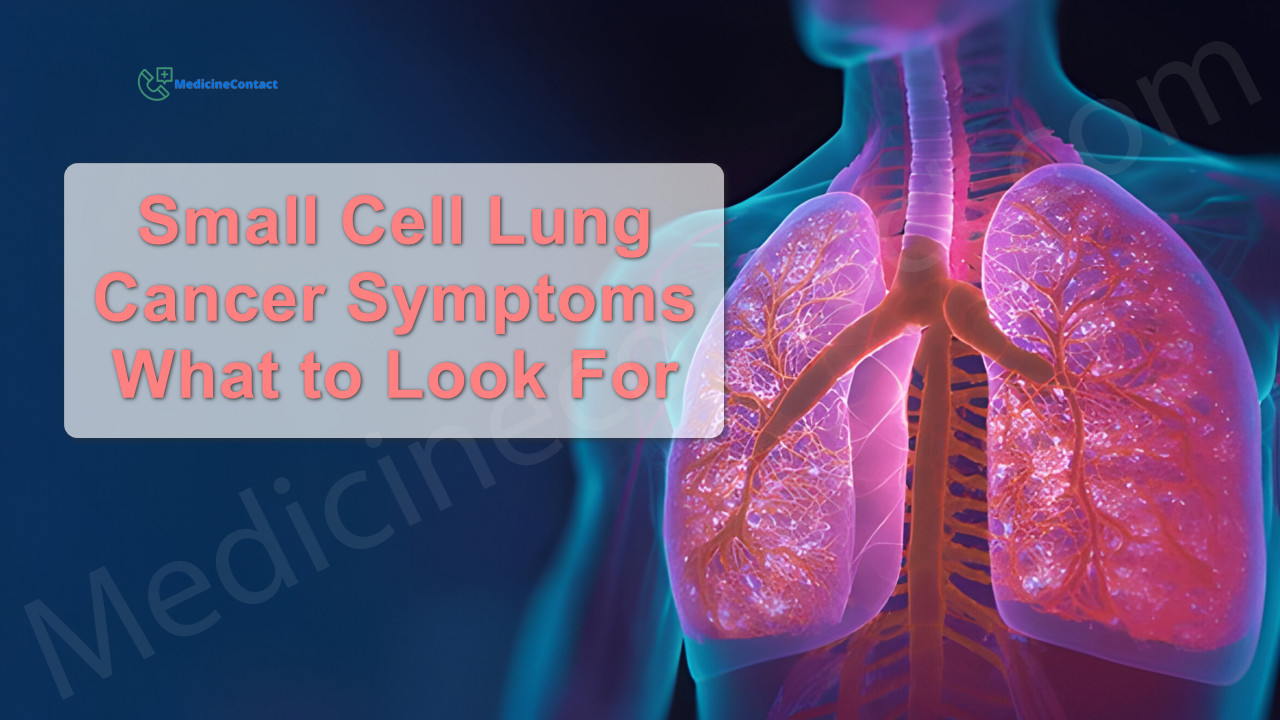
Introduction
Lung cancer is one of the most common and deadly types of cancer, affecting millions of people worldwide. Among the various types of lung cancer, small cell lung cancer (SCLC) stands out because it is aggressive and progresses quickly. It's important to recognize the symptoms early on for timely treatment and better outcomes.
Small cell lung cancer (SCLC) makes up about 10-15% of all lung cancers. Unlike non-small cell lung cancer (NSCLC), SCLC grows rapidly and tends to spread quickly to other parts of the body. This means that being aware of its symptoms and getting diagnosed promptly are crucial in managing this difficult disease.
Understanding the symptoms of SCLC can empower individuals to seek medical advice sooner, leading to earlier diagnosis and potentially more effective treatment. By reading this article, you will gain:
- Insights into the common and less common symptoms associated with SCLC.
- Knowledge about the importance of early detection for improving patient outcomes.
- Awareness of the risk factors contributing to SCLC.
Lung cancer awareness is vital, not only for those at risk but also for their loved ones and healthcare providers. Recognizing the distinctive features of small cell carcinoma helps in addressing this formidable health challenge effectively.
For comprehensive information on lung health, visit Lung & Respiratory.
Comprehending Lung Cancer
Lung cancer is a complex disease that can be divided into two main types: non-small cell lung cancer (NSCLC) and small cell lung cancer (SCLC). It's important to understand these classifications because they highlight the diverse nature of lung cancer and its implications.
Differences Between Non-Small Cell Lung Cancer (NSCLC) and Small Cell Lung Cancer (SCLC)
Non-Small Cell Lung Cancer (NSCLC)
- Accounts for 80-85% of all lung cancers.
- Includes several subtypes with different characteristics and behaviors, such as adenocarcinoma, squamous cell carcinoma, and large cell carcinoma.
Small Cell Lung Cancer (SCLC)
- Makes up about 10-15% of lung cancers.
- Known for its fast growth and early spread to other parts of the body.
- Unlike NSCLC, SCLC often responds well to chemotherapy and radiation therapy but has a high chance of coming back.
Types of Lung Cancer
Non-Small Cell Lung Cancer (NSCLC)
NSCLC can be further divided into several subtypes, each with its own unique features:
- Adenocarcinoma: The most common subtype of NSCLC that affects both smokers and non-smokers. It is more common in women and younger people and is often found in the outer areas of the lungs.
- Squamous Cell Carcinoma: Strongly linked to smoking, this type usually occurs in the central part of the lungs near the bronchus. It tends to grow slowly compared to other NSCLC subtypes.
- Large Cell Carcinoma: This subtype can occur anywhere in the lungs and tends to grow quickly. It is less common than adenocarcinoma or squamous cell carcinoma.
- Rare Subtypes: There are also less common subtypes like adenosquamous carcinoma and sarcomatoid carcinoma that are important to recognize even though they are not diagnosed as frequently.
Small Cell Lung Cancer (SCLC)
SCLC is characterized by its aggressive nature and tendency to spread early:
- Also known as small cell carcinoma or small cell neuroendocrine carcinoma.
- Often diagnosed after it has already spread beyond the lungs.
- Characterized by small cells that multiply rapidly, forming large tumors.
Understanding these differences helps us identify specific symptoms associated with each type. For example, symptoms of non-small cell lung cancer may include persistent cough or chest pain, while symptoms of small cell lung carcinoma often manifest as more severe respiratory issues due to its rapid progression.
Recognizing these distinctions not only aids in timely diagnosis but also guides appropriate treatment strategies tailored to each subtype's behavior.
Recognizing Symptoms Early: A Key to Timely Intervention in Small Cell Lung Cancer (SCLC)
Importance of Early Detection
Recognizing small cell lung cancer symptoms early can significantly improve patient outcomes. This aggressive form of lung cancer tends to grow and spread rapidly, making timely diagnosis crucial. Early detection increases the chances of effective treatment and better prognosis.
Early Warning Signs
When it comes to signs of SCLC, patients might initially experience subtle symptoms that are easy to overlook. Key signs include:
- Persistent cough: A chronic cough that does not go away or worsens over time.
- Chest pain: Pain or discomfort in the chest area, often exacerbated by deep breathing, coughing, or laughing.
Common Symptoms Associated with Small Cell Lung Cancer (SCLC)
Understanding the common symptoms associated with SCLC helps in identifying this condition at an earlier stage. Frequently observed symptoms include:
- Shortness of breath: Difficulty breathing or feeling out of breath during routine activities.
- Unintended weight loss: Significant weight loss without changes in diet or exercise habits.
- Fatigue: Persistent tiredness or lack of energy despite adequate rest.
Less Common but Significant Symptoms
While some symptoms are more prevalent, others might be less common but equally important indicators of small cell lung cancer:
- Wheezing: A whistling sound while breathing can indicate airway obstruction caused by the tumor.
- Blood in sputum: Also known as hemoptysis, coughing up blood-streaked mucus is a serious sign that warrants immediate medical attention.
- Hoarseness: Changes in voice quality, such as becoming raspy or hoarse, may result from tumors pressing on nerves controlling the vocal cords.
By being vigilant about these symptoms of small cell lung cancer, individuals can seek prompt medical advice. Early intervention plays a pivotal role in managing SCLC effectively. Understanding these signs not only aids patients but also enables healthcare providers specializing in Lung & Respiratory oncology to deliver more targeted care.
Recognizing these early warning signs and understanding their implications contributes significantly toward improving survival rates for those diagnosed with small cell carcinoma. This awareness underscores the importance of timely medical evaluations and appropriate diagnostic measures for anyone experiencing potential symptoms indicative of SCLC.
Risk Factors for Developing Small Cell Lung Cancer (SCLC)
Major Contributors to SCLC Development
Understanding the risk factors for small cell lung cancer (SCLC) is crucial in both prevention and early detection. Smoking remains the most significant risk factor:
- Tobacco Use: Approximately 90% of SCLC cases are linked to cigarette smoking. The carcinogens in tobacco smoke cause extensive damage to lung tissues, leading to mutations that can result in cancer.
- Secondhand Smoke: Even non-smokers exposed to secondhand smoke face an increased risk of developing SCLC.
Occupational Exposure to Carcinogens
Certain occupational environments expose individuals to harmful substances that elevate their risk:
- Asbestos: Commonly used in construction and shipbuilding, asbestos fibers can be inhaled, causing lung damage over time.
- Radon: This naturally occurring radioactive gas can accumulate in homes and buildings, especially in basements and ground floors.
Other Notable Risk Factors
Other notable risk factors include:
- Family History: Genetic predisposition plays a role, with a higher likelihood of developing SCLC if there is a family history of lung cancer.
- Pre-existing Lung Diseases: Chronic obstructive pulmonary disease (COPD) and other chronic lung conditions also increase susceptibility.
Early identification of these risk factors can lead to more proactive measures, potentially reducing the incidence and improving outcomes for those at high risk of developing SCLC.
Diagnostic Methods for Small Cell Lung Cancer (SCLC) Detection and Staging
Identifying and staging small cell lung cancer (SCLC) accurately is crucial for determining the most effective treatment strategies. Early diagnosis can significantly improve outcomes, making it essential to understand the various diagnostic methods available.
Imaging Tests Used in Diagnosing SCLC
Imaging tests are often the first step in diagnosing SCLC. These tests help visualize abnormalities in the lungs and assess how far the cancer has spread:
- Chest X-ray: A simple and quick imaging test that can reveal masses or nodules in the lungs.
- Computed Tomography (CT) Scan: Provides detailed cross-sectional images of the lungs, helping to determine the size, shape, and location of tumors.
- Positron Emission Tomography (PET) Scan: Often combined with CT scans to detect areas of high metabolic activity indicative of cancer cells.
- Magnetic Resonance Imaging (MRI): Useful for evaluating potential metastasis to the brain or spinal cord.
Biopsy Techniques
A definitive diagnosis of SCLC requires a biopsy, where tissue samples are examined under a microscope to identify cancer cells:
- Bronchoscopy: A flexible tube is inserted through the nose or mouth into the lungs to collect tissue samples.
- Needle Biopsy: A needle is inserted through the skin into the lung or lymph nodes to obtain tissue.
- Thoracentesis: Involves extracting fluid from around the lungs to check for cancer cells.
- Mediastinoscopy: A surgical procedure to examine and take samples from lymph nodes in the chest.
Staging of Small Cell Lung Cancer
Staging helps determine how advanced the cancer is and guides treatment decisions. SCLC staging typically falls into two main categories:
- Limited Stage: Cancer is confined to one side of the chest and can be treated within a single radiation field.
- Extensive Stage: Cancer has spread beyond one side of the chest or to other parts of the body.
Staging may involve additional imaging tests like bone scans or MRIs, as well as procedures like endobronchial ultrasound (EBUS) for more precise evaluation.
Treatment Options Available for Patients with Small Cell Lung Cancer (SCLC)
Once diagnosed, treatment for SCLC often begins promptly due to its aggressive nature. Traditional treatment approaches include:
Chemotherapy
Chemotherapy remains a cornerstone in SCLC treatment due to its rapid growth rate:
- First-Line Chemotherapy: Commonly involves platinum-based drugs such as cisplatin or carboplatin combined with etoposide.
- Second-Line Chemotherapy: For patients who relapse, options like topotecan or irinotecan may be considered.
Radiation Therapy
Radiation therapy is frequently used alongside chemotherapy:
- Thoracic Radiotherapy: Targets tumors within the chest, often administered concurrently with chemotherapy in limited stage disease.
- Prophylactic Cranial Irradiation (PCI): Preventive measure to reduce brain metastasis risk in patients responding well to initial treatments.
Emerging Therapies
Innovative therapies are being investigated through clinical trials aiming to improve outcomes for SCLC patients:
- Immunotherapy: Drugs like atezolizumab and nivolumab have shown promise by enhancing the immune system's ability to target cancer cells.
- Targeted Therapy: Research focuses on identifying specific genetic mutations within SCLC tumors that could be targeted by new drugs.
These emerging therapies represent a significant advancement in lung oncology, offering hope for improved survival rates and quality of life for individuals battling this challenging disease.
Understanding these diagnostic methods and treatment options empowers patients and healthcare providers alike, fostering timely interventions that can make a critical difference in managing small cell lung cancer.
2. Emerging Therapies: Clinical Trials Exploring New Frontiers in Treating Small Cell Lung Cancer (SCLC)
Progress in treating small cell lung cancer (SCLC) is being driven by cutting-edge clinical trials that explore innovative therapies. These trials aim to improve outcomes for patients with advanced-stage or refractory SCLC who have limited treatment options.
Immunotherapy
Immunotherapy has shown promise in targeting SCLC by harnessing the body's immune system to combat cancer cells. Agents such as checkpoint inhibitors are being evaluated for their ability to prolong survival and enhance the quality of life for patients.
Targeted Therapies
Targeted therapies focus on specific molecular alterations within tumors. These precision medicines aim to disrupt cancer growth pathways, offering a more personalized approach to treatment. Researchers are investigating drugs that target genetic mutations and aberrant signaling pathways unique to SCLC.
Emerging therapies signify hope, with ongoing research continually pushing the boundaries of what is possible in oncology. The integration of genomic profiling techniques further aids in tailoring treatments to individual patient needs, potentially transforming prognosis and survival rates for those battling this aggressive disease.
For a comprehensive understanding of diagnostic tools and the importance of staging in determining appropriate treatment options for SCLC, visit Lung & Respiratory.
Prognosis, Survival Rates, and Ongoing Research Efforts Targeting Small Cell Lung Cancer (SCLCs)
Factors Influencing Survival Rates
Survival rates for small cell lung cancer (SCLC) are significantly influenced by various factors, including the stage at diagnosis and overall health of the patient. For individuals diagnosed at an early stage, the 5-year survival rate is approximately 31%. However, this rate drops drastically for those with advanced-stage SCLC, highlighting the aggressive nature of this malignancy.
Recent Advancements in Research
Recent advancements in lung oncology have provided new insights into improving prognoses for patients with SCLC:
- Clinical Trials: Investigational therapies such as immunotherapy and targeted therapy are actively being explored in clinical trials. These novel treatments aim to offer more effective management strategies against SCLC.
- Genomic Profiling: Techniques in genomic profiling are becoming increasingly important in personalizing therapeutic interventions. By identifying specific molecular alterations within tumors, oncologists can tailor treatments to target these unique characteristics, potentially improving outcomes.
Promising Areas of Study
Efforts within research communities continue to focus on several promising areas:
- Immunotherapy: Early studies suggest that combining immunotherapy with traditional chemotherapy may enhance treatment efficacy.
- Targeted Therapy: Identifying biomarkers that predict response to targeted agents could revolutionize treatment protocols.
- Combination Therapies: Exploring combinations of different therapeutic modalities to maximize patient benefit.
Future Directions
The integration of these innovative approaches holds promise for better management of SCLC. As our understanding of the molecular underpinnings of SCLC deepens, future research may yield even more effective treatments tailored to individual patient profiles.
Understanding and leveraging these emerging trends is critical in the fight against this aggressive disease subtype. Continued investment in research is essential for developing more robust treatment options and improving survival rates for patients battling small cell lung cancer.
For additional information on lung cancer classifications and treatments, refer to Lung & Respiratory.
Conclusion: Empowering Awareness through Knowledge About Small Cell Lung Carcinoma's Distinctive Features
Recognizing and understanding the unique characteristics of small cell lung carcinoma (SCLC) is crucial for timely intervention. This aggressive form of lung cancer, characterized by rapid growth and early spread, demands prompt attention from both patients and healthcare providers.
Key takeaways include:
- Timely Recognition: Early detection significantly improves outcomes. Healthcare providers must remain vigilant, identifying SCLC symptoms promptly to initiate appropriate treatments.
- Rapid Growth and Early Spread: Malignant cells originating from neuroendocrine lineages exhibit fast proliferation and a tendency to spread swiftly across distant sites in the body.
- Comprehensive Diagnostic Approach: Rely on advanced imaging techniques and histopathological evaluations rather than just physical examinations to confirm the presence or absence of abnormalities.
Encouraging readers to seek professional medical advice if they experience concerning respiratory symptoms is essential. Early consultations can lead to further investigations beyond initial reassurances, ensuring that any abnormalities are thoroughly assessed, whether symptomatic or asymptomatic.
Understanding SCLC's distinctive features empowers individuals to take proactive steps towards their lung health, emphasizing the importance of awareness in combating this challenging form of cancer within the broader context of Lung & Respiratory oncology.
FAQs (Frequently Asked Questions)
What is small cell lung cancer (SCLC) and why is it significant?
Small cell lung cancer (SCLC) is a type of lung cancer characterized by rapidly growing cancer cells. It holds significance in the context of lung cancer awareness due to its aggressive nature and the importance of early detection, which can greatly influence treatment outcomes.
What are the common symptoms associated with small cell lung cancer?
Common symptoms of small cell lung cancer include persistent cough, chest pain, wheezing, and blood in sputum. Recognizing these symptoms early is crucial for timely intervention and improving patient outcomes.
What are the main risk factors for developing small cell lung cancer?
The primary risk factor for developing small cell lung cancer is tobacco use. Other factors include occupational exposure to carcinogens and a history of respiratory diseases.
How is small cell lung cancer diagnosed and staged?
Diagnosis of small cell lung cancer typically involves imaging tests such as CT scans, along with biopsies to confirm the presence of cancer cells. Staging is essential to determine the extent of disease spread and guide treatment options.
What treatment options are available for patients with small cell lung cancer?
Treatment options for small cell lung cancer primarily include chemotherapy and radiation therapy. Emerging therapies, including clinical trials exploring immunotherapy and targeted therapy, are also being investigated to improve patient outcomes.
What factors influence the prognosis and survival rates for patients with small cell lung cancer?
Prognosis and survival rates for patients with small cell lung cancer are influenced by several factors, including the stage at diagnosis, overall health, response to treatment, and advancements in research focusing on personalized therapeutic interventions.
Disclaimer: This article is for informational purposes only and does not constitute medical advice. Always consult with a healthcare professional before starting any new treatment regimen.




